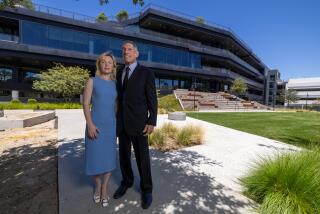New Digs
- Share via
Cal State Fullerton’s anthropology department is sitting on a gold mine--and knows it.
Anthropology, after all, is the study of humankind, its cultures and all its myriad behaviors, and with Southern California acknowledged as one of the world’s largest ethnic salad bowls, the match has been perfect.
The Fullerton program has taken advantage of this, supplementing classroom studies with work in the community. And the department has thrived:
Enrollment in its undergraduate and master’s programs has doubled over the past three years, far outpacing the growth at other anthropology departments nationwide. The number of student anthropology clubs has jumped from two to eight. And many graduates, having begun careers locally, retain active ties to the college.
The Fullerton program can point to these strengths despite being handicapped for years by tight quarters, budget cuts and outmoded facilities. The ethnographic cultural analysis lab, for example, consists of one computer and one storage shelf in a faculty member’s office, says department Chairwoman Susan Parman.
But those handicaps will soon be memories.
A 10,000-square-foot teaching and research facility is under construction on campus, thanks in part to a $1-million federal grant. The facility will include four state-of-the-art labs, a museum, a conference room, offices and study areas, all wired to serve as a sort of anthropology superhighway of data sharing.
That the grant money came from the National Science Foundation adds prestige to the project, says David Givens, director of academic relations at the American Anthropological Assn. in Arlington, Va.
“Fullerton is a very high-quality program,” Givens said. “The faculty is very real-world, with good links to the community. At some campuses there’s very little involvement. The ivy walls are really high.
“At Fullerton, not only do faculty members know theory, but they know how to apply it to the career realm for students--a mix of applied anthropologists along with more traditional academic faculty.”
The new facility, due to be completed by fall 1997, will enhance that blend, says Parman, who is a strong proponent of an interdisciplinary, “four field” approach to anthropology.
The four sub-disciplines--cultural, linguistic, archeological and physical anthropology--not only will be addressed in concept but also will be “physically tethered” at the facility, Givens says.
With fiber-optic cable linking the various labs to one another and eventually to the campus as a whole, students and researchers will be able to create compound documents on a Web site.
For example, Parman says, students studying primate behavior at the Santa Ana Zoo could enter their findings, while archeologists could add data on ancient primate habitats. Then visual anthropologists might add film clips and other visual representations of the relevant primates, while cultural anthropologists add information on why and how studying primates is relevant to studying humankind.
Such a document, Parman says, would be an evolving tool and could form the basis for a series of exhibits at the facility’s museum.
Other community-based anthropology projects will be enhanced by the resources at the new center, says professor Jacob Pandian, the facility’s funding campaign coordinator and the chairman of the department for 18 years before he stepped down this year.
Among the projects:
* An ongoing archeology dig off Ortega Highway in which students are excavating and analyzing evidence of a “milling stone” culture between 5,000 and 8,000 years old;
* Student research into differing cultural attitudes toward doctors and hospitals, which has become a training tool for Kaiser health care workers;
* The forensic study of human bones under the supervision of professor Judy M. Suchey, who contracts with Southland coroners on crime scene investigations;
* And the biannual Ethnic Bazaar fund-raiser, an on-campus collaboration between anthropology students and local merchants.
To build the center, the university has provided $447,000 to supplement the $1-million federal grant. An additional $600,000 is needed, however, and that’s where department alumni come in, says Norm Rosen, a 1994 master’s graduate.
As chairman of the Anthropology Building Council, Rosen is tapping the goodwill of anthropology graduates for the capital campaign fund. And Rosen gave a sizable donation himself.
“The reason I gave a lot is that my experience at Fullerton was so wonderful,” Rosen says. “I have a lot of schooling, and the years I spent at Fullerton were the most fulfilling I’ve had. There’s a tremendous amount of esprit de corps among both graduates and undergraduates.”
Education in anthropology provides critical skills for today’s cross-cultural business world, and the new facility will help provide them, Rosen says. Anthropology graduates find careers not only in museums and research but also in personnel departments, public utilities and market research firms.
Enrollment in anthropology courses nationwide has risen by a third since 1993, says Givens at the Anthropological Assn.
“It provides a well-rounded approach that people find useful in their careers,” Givens says. “Anthropology prepares people for a multicultural work force, prepares them for what actually happens in the workplace.
“The ethnography concept”--the systematic recording of human culture and behaviors--”is hot in business right now,” Givens says by way of example. “We recently had a request from Kodak for anthropologists who could study disposable cameras, to see how people actually used them, when and why. This research would be instead of Kodak simply relying on forms that consumers might or might not mail in.”
The goal at Fullerton’s new facility is to emphasize the strengths of a multidisciplinary approach to anthropology without diluting the department’s specialties, says Parman, who wrote the grant application on behalf of the university. Fragmentation of anthropology curricula into other academic departments has hurt many other anthropology programs nationwide, Givens says, notably UC Berkeley’s.
“We see this kind of fragmentation going on in our own students, and we have to keep herding them back from their specialization,” Parman says.
“Students may only be interested in primatology, but they know that what they’re getting a degree in is anthropology. This is the vision, an active explicit vision of the new facility: that even those actively pursuing specialization are being brought back toward the center.”
More to Read
Sign up for Essential California
The most important California stories and recommendations in your inbox every morning.
You may occasionally receive promotional content from the Los Angeles Times.










